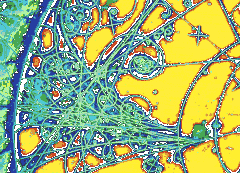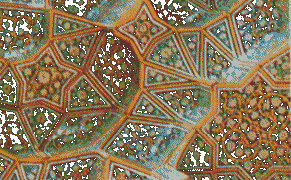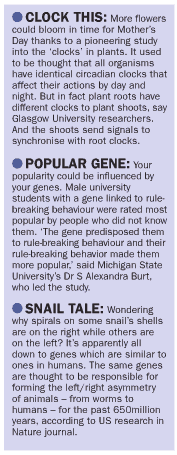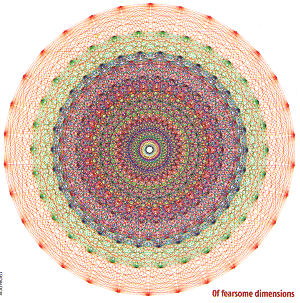
Science |
 |
All crystals great and smallNo two snowflakes are alike, but they're all symmetrical;as they crystallise and separate, some flakes may be close to mirror images of others. |
 |
Although worlds apart from the delicate snowflake, basalt columns at the Giant's Causeway in Antrim, Northern Ireland, are also strikingly symmetrical. Thousands of (mainly) six-sided pillars formed when lava cooled suddenly. |
Our universe is full of natural,neatly organised patterns. This symmetry could be the key that will unlock some cosmic puzzles. [Ref:Video:BB14:RI 5]
Crystals,snowflakes,the Great Pyramids,stacks of fruit in shop windows,all possess a quality we find naturally appealing: symmetry. It has fascinated artists for centuries.Now scientists believe it holds the key to the universe.We all know symmetry when we see it. It's a basic regularity,a simple self-similarity, where the whole consists of similar parts. It sounds obvious but, as scientists and mathematicians are discovering, symmetry is incredibly profound.Our lives, even the very nature of the cosmos,may depend on its properties.
Life is full of obvious ''aesthetic symmetry" - tiling patterns, company logos, the drawings of Escher - but sometimes its presence lurks beneath the surface, serving a practical purpose.In metric paper sizes A3, etc) the proportions ensure that when you cut a sheet in half, you end up with two sheets with the same proportions as the original. The symmetry of gaming dice is necessary to ensure that all six numbers always have an equal probability of coming up.It was the beauty of symmetry, rather than its usefulness,that first attracted human curiosity. Crystals provide some of the most striking examples. Salt has a simple cubic symmetry , while in the more complex "ortho-rhombic" structure of sulphur,the sides are unequal but an overall symmetry remains.
|
Molecules of common salt - sodium chloride - are regular (the irregularities are from other constituents) |
Perhaps the most spectacular example is the Giant's Causeway on the north-west coast of Northern Ireland where volcanic basalt has been frozen by the cold sea into massive six-sided columns.These natural symmetries are the result of atomic forces within the crystals vying for control of molecules,and reach a stable state when the when the molecules take up a symmetrical arrangement.
Although they knew none of this, the ancient Greeks saw that something fundamental was going on in crystals, and sought connections between symmetrical shapes and the cosmos.
The Greeks identified five fundamental shapes - the ''Platonic solids" - to which were linked the four elements and the cosmos itself.The triangular-faced tetrahedron was linked to fire, the cube to earth. the diamond-like octahedron to air, and the 20-sided icosahedron to
Swirling galaxies in a dark-matter universeScientists are searching for particles predicted by supersymmetry. These enigmatic particles could be the source of the "dark matter that pervades the cosmos. This dark matter helps explain why galaxies form spirals. |
water. The dodecahedron with its 12 sides was associated with the cosmos.Such notions may seem quaint today, but the Greeks were groping towards an idea that is at the centre of modern theories of the universe: that the beauty of symmetry is more than aesthetic, it's mathematical.
As early as the 4th century BC, Greek mathematicians had proved the Platonic solids were special: they are the only ones whose faces are identical regular polygons with edges of equal length.Our universe permits only five perfectly symmetric three-dimensional arrangements of polygons.No others will work.
Almost 2000 years later,the 16th-century German astronomer Johannes Kepler used this fact in his theory of the solar system.Six known planets, five gaps between them, five Platonic solids to explain the gaps. Symmetrical,beautiful - and wrong. Kepler's belief in regularity was, however,rewarded by his discovery of the laws of planetary motion.
Since then mathematicians have studied symmetry in great detail and revealed some curious things. For example, in everyday mathematics, it makes no difference what order you do something: A plus B is the same as B plus A [This is not true in Qphysics when multiplying,thus non-commutative arithmetic-LB].But in the mathematics of symmetry, it does .Put this magazine down, turn it over towards you, then rotate it Clock-wise 90 degrees on the table: its spine is furthest away from you. Now do reverse the order: this time the spine is nearest you.
This difference is a key property of "group theory", the mathematics of symmetry discovered by Evariste Galois, a French genius who died after a duel in 1832 at the age of just 20.
|
Icosahedron (20 sides) :Dodecahedron (12 sides) :Octahedron (8 sides) :Hexahedron,cube (6 sides) :Tetrahedron (4 sides)The Platonic SolidsThese five essential shapes are the only conceivable solids whose sides and edges are exactly the same.They are also the only perfectly symmetrical three-dimensional polygons. |
In maths, a group is a set of theoretical objects that when manipulated and combined in certain ways always produce a result that also belongs to the group.Symmetrical objects are a good example - a square turned through a right angle is always still a square.
Mathematicians turn to group theory when a problem involves symmetry. Remember the Rubik Cube? It- was group theory that provided a way to calculate theoretically how to finish it from any starting position.This might seem like the kind of thing only mathematicians get excited about, but symmetry has a habit of popping up in unlikely places.
During World War II symmetries in the workings of the German Enigma cipher machine could be inferred and exploited by Allied code-breakers[Ref: A.Turing:Video N27: Cracking the Code ;N45 Station X:Red File2 Turing.wri;Bletch.wri].
For example, if the machine coded the letter A as G , then (with the machine operating on the same setting) G would be encoded as A.Using group theory,the code-breakers also found that the Enigma machines had fatal flaw in their design, making breaking the code far easier than it first appeared.
After the war, symmetry and group theory turned up in the more mind-boggling area particle physics.During the 1950's scientists probing the nature of matter using particle accelerators turned up new ''fundamental'' particles to add to the electron, proton and neutron.
As they went into the dozens and then scores, the numbers of these supposedly fundamental particles started to worry scientists. So for classification, each particle was described in terms of certain quantum properties such as "spin" or ''strangeness''.
|
Atoms can be arranged into an octahedron as this model shows. |
After identifying the properties of each particle, the theorists noticed something odd: if the particles were gathered together according to their properties,patterns emerged.Plotted on paper, some particles grouped into a hexagon, others into a triangle. It seemed as if, just as the Greeks had suspected, symmetry was at work at the most fundamental level of matter.
|
Tragedy of the "wrong type of symmetry" |
Theorists such as Murray Gell-Mann pursued this discovery using group theory. Where a gap appeared in the pattern, they worked out the properties an unseen particle should have to fill it. These "deduced" particles were duly found, and they had just the properties predicted.
Today group theory and symmetry , once regarded as esoteric branches of mathematics, are part of the basic toolkit of the theoretical physicist.
However, just as American physicists were beginning to discover the beauty of mathematical symmetry , its dark side was being revealed in a medical tragedy then unfolding in Europe. Babies were being born with severe defects - deformed faces, flipper-like legs, stubby fingers on stunted arms.It emerged that all the mothers had taken a new drug to combat morning sickness: thalidomide [Ref : "A Private Matter" -The Finkbine case].
The hand and forearm of one of the estimated 10,000 "thalidomide babies" born in the early 1960s in the UK and Germany.Thalidomide,introduced in the late 1950s as "safe" medicine for pregnant women,was in fact a 50-50 mix of two mirror image chemicals.Tragically,only one form of Thalidomide turned out to be safe:its mirror image twin was responsible for birth defects.
The thalidomide tragedy had its origins in a type of symmetry now known to be of fundamental importance in the chemistry of life: "chirality" [Ref Video:BB10 RI Lecture "Man in the Mirror"]. Taking its name from the Greek for hand, chirality is about left- and right-handedness - mirror symmetry.
When you look at the word "nib" in a mirror , its chiral partner is revealed: "din" Similarly ,as Louis Pasteur discovered in 1848. many chemicals have left-and right-handed versions, known as isomers.And, as he also discovered, organisms react differently to different isomers.
Like chiral words with their mirror-image letters and different meanings, chemical isomers have the same atoms but can have very different properties -especially when involved in the delicate biochemical reactions involved in living organisms.
Mirror-image moleculesThese are the left and right-handed forms of the amino acid alanine.In the human body,each of the 20 amino acids occurs in one chiral form only. |
Some of these differences are bizarre: one isomer of the compound limonene, for example, tastes of oranges; its mirror image tastes of lemons.With thalidomide the differences are far more dramatic: one isomer of the drug is extremely effective at combating morning sickness; the other causes appalling birth defects. Because the manufacturers were unaware of the radically different properties of each,the drug given to the mothers was a 50-50 mix of both isomers.
Despite this disaster, only recently has the pharmaceutical industry addressed the dangers of the wrong type of symmetry.The American Food and Drug Administration now demands that safety tests be carried out on both isomers of a new compound. Several British companies, such as Chiroscience in Cambridge, now specialise in sifting out the dangerous isomers of existing drugs.
The importance of getting the right symmetry in pharmaceuticals reflects a curious fact about many biochemicals: they come in either entirely left- or right- handed forms. But when industrial chemists make, say, amino acids, the result is inevitably a 50-50 mix of left and right.
Various explanations have been put forward. One clue comes from the fact that,because of its structure, the naturally preferred amino acid isomer requires a tiny bit less energy to make. The difference is minimal: just one part in 100,000 million million. Perhaps some imbalance in the forces at work billions of years ago, when life was emerging,turned this tiny difference into the dominance of certain isomers we see today.
 |
Weird science |
An intriguing possibility is that one of the fundamental forces that govern the cosmos could be responsible for this "handedness" of life. In 1956 scientists discovered that the "weak force" which controls one type of radioactivity, produces "mirror-image"particles, whose properties are reflections of the norm.
Even the smallest units in the universe,elemental particles of matter and force -like these leptons revealing themselves in a bubble chamber- obey symmetrical laws as the flip around.For every group of properties one particle displays,there's another exhibiting their mirror image.
This bizarre property is unique among the fundamental forces - it's a bit like discovering that some apples fall upwards into trees if watched in a mirror.Yet scientists speculate that the influence of the weak force on the early earth's chemistry could account for the prevalence of particular amino acid isomers in living organisms today.
This property of the weak force also means that the entire universe has a sense of left and right, built into it since the Big Bang [Ref: I.Asimov "The Left Hand of the Electron"]. This is far from being the only connection between symmetry and the universe, however. Many theoretical physicists now believe that symmetry holds the key to the universe.
For decades scientists have been trying to construct a single "theory of everything", encompassing every form of matter and every type of force acting on it. This means finding connections between particles of matter, such as the electron and proton, and particles that transmit the fundamental forces, like photons. The problem is, force-carrying particles are utterly unlike particles of matter
The situation is reminiscent of the 1950s, when theorists tried to get to grips with the plethora of particles produced by accelerators.Again it seems the solution lies in symmetry.
 |
Raise your eyes to heaven Symmetry amid complexity was essential to Islamic advances in astronomy and mathematics, particularly trigonometry and geometry,around the end of the first millennium AD.This enlightened fascination is revealed in the ceramic extravaganzas on mosque ceilings. |
By combining group theory with relativity and quantum physics - the rules of the early universe - scientists have arrived at an astounding theory. In the intense heat of the Big Bang, all the particles we can now detect were part of a single huge family,governed by a single overarching mathematical concept, which is known as "supersymmetry".
As the universe cooled, however, supersymmetry started to break down. As particle families specialised, the connections between them began to disintegrate Some, like the electron, went on to form matter; while others, like the photon, went on to become carriers of fundamental forces.
The forces themselves split up as the universe cooled, and the original cosmic symmetry broke apart. The "strong" nuclear force, which binds together the hearts of atoms, split from the "electroweak'' force, which in turn split up to form the electromagnetic and weak forces.
In the last few years, the incredibly powerful particle accelerator at CERN, the European nuclear research centre in Geneva, has re-created events in the very early universe and found evidence that supersymmetry did indeed play a role in creating the universe around us.
Scientists are now searching for "supersymmetric" particles predicted by the theory. If the search is successful, it will be spectacular proof that, as the Greeks suspected 2,500 years ago, symmetry really does lie at the root of all things.
Jonathan Wilson .
 |
THE TAMING OF THE SYMMETRIES |
|
| Many physicists think that unifying gravity and other forces
will require a theory embracing about 11 space-time
dimensions, give or take a few. To put that in perspective, mathematicians
have now mapped the workings of an esoteric 248-dimensional structure. Physicists
must surely be encouraged. The structure, called E8,was explored
by Jeffrey Adams from the university of Maryland, College Park, and 17 other
mathematicians. "E8 was discovered in 1887 and until now, no one
thought the structure could ever be understood," says Adams. E8 is an example of a so-called Lie group, defined by Norwegian mathematician Sophus Lie in the 19th century to study symmetry. A Lie group underlies objects like balls, cylinders or cones that are symmetrical under any degree of rotation. The E8 group encapsulates the symmetries of a geometric object, but in 57 dimensions. The E8 stucture itself has 248 dimensions. The task was effectively to unpack all the information about E8 - the catalogue of objects it can act on and how it acts. Adams's team took four years to solve the problem using a supercomputer. The resulting map of E8, incorporating 60 gigabytes of data, would cover an area the size of Manhattan if written out in tiny print. |
 |
|
| Hermann Nicolai of the Albert Einstein Institute in Potsdam, Germany, says that the unique structure of E8 might help in the quest for a theory of everything. He says this is because the underlying symmetries of any unified theory "will require an extremely special structure, mathematically speaking, and E8, is an example that might fit the bill".[New Scientist 24 Mar 07 p6]. | ||
![]() Oct 94 p62
Oct 94 p62
File Info: Created --/--/-- Updated 27/3/2007 Page Address: